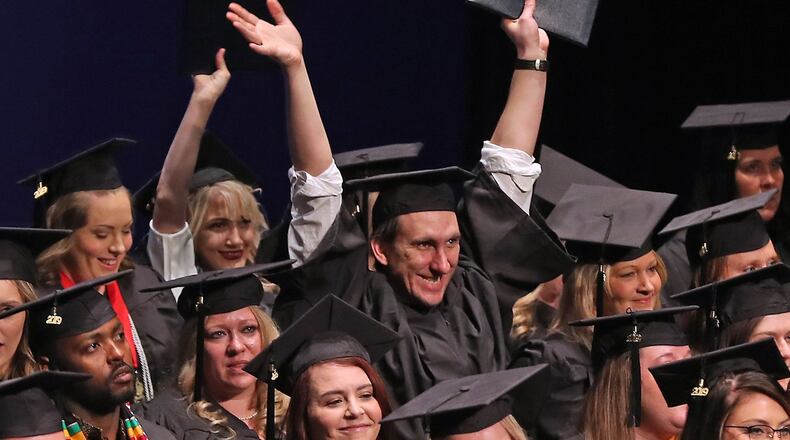Ohio ranked 31st among states. Regionally, Ohio was tied with Michigan, ahead of Indiana and West Virginia, but behind Pennsylvania and Kentucky. After three straight years with gains of half a percentage point or less, Ohio doubled that, rising from 44.6% to 45.5%.
RELATED: New intern program opens doors for high schoolers
Tom Lasley, CEO of Learn to Earn Dayton and a member of several local education/workforce efforts, said he thinks there’s a good chance Ohio has kept that 2018 momentum. Lasley said Gov. Mike DeWine’s administration “has much more aggressively embraced” the idea that economic development is tied to educational attainment.
“You can have all sorts of good, healthy debate about whether people need four-year degrees or two-year degrees or what kind of post-secondary credential it is, but if you don’t have sufficient talent in your population, you’re not going to grow your economy, and that is just a flat, dead fact.”
The Lumina Foundation set a national goal of having 60 percent of Americans hold some type of post-high school credential by the year 2025. That could be a certification in fields like HVAC, welding or machining, up through associate and bachelor’s degrees, to graduate and professional degrees.
Lumina set that goal citing an ongoing “global shift from an industrial economy to a knowledge economy,” with more and more newly created jobs requiring some form of post-high school training.
Dayton ranks lower
Lumina’s data for metro areas only includes associate degrees and above, not certificates. By that metric, Dayton ranks fifth among Ohio’s six largest metro areas in 2018. At 41.6 percent, the Dayton metro was two percentage points ahead of Toledo, and about one point behind Cleveland and Akron. Columbus was No. 1 at 46.5 percent.
But like the state as a whole, there’s reason to hope Dayton is building momentum. Lasley said Learn to Earn data showed the percentage of all Montgomery County 2013 high school grads who completed a college degree by 2019 inched to a new high of 38%.
Sinclair Community College interim provost Kathleen Cleary said her school has seen significant recent gains, more than doubling the number of degrees and certificates awarded, from 3,600 in 2015 to 8,100 in 2019.
RELATED: Dayton turning second high school into career center
Sinclair’s associate degree completion rate has also soared, from 11 percent in 2012 to 27 percent in 2018. Some of those students don’t earn a degree because they were only at Sinclair to earn an industry certificate or other credential.
But Cleary said the college is working to understand and mitigate the obstacles that do remain for students at risk of dropping out. She said about 40 percent of those who leave school have an “A” or “B” average, but they run into financial problems, family problems, health issues or changing work schedules.
Cleary said Sinclair now offers an emergency grant program of up to $500 to make sure a car repair or unexpected expense doesn’t cause someone to walk away. And the school is trying to integrate tutoring resources directly into classrooms in some cases, so students don’t always have to make special outreach.
She urged people thinking about going back to school for a new job or to change their lives to “tell us your story.”
“If people are out there and feel stuck, the best way to get unstuck is to give us a call (at 937-512-3675),” Cleary said. “People sometimes feel like there’s a million reasons why they can’t go back to college. But there are a million resources we have here to try to address the issues people are having.”
High school efforts
Two years ago, the Lumina Foundation designated the Dayton region as a Talent Hub for its efforts to increase college access and attainment. Lasley said there’s no silver bullet, but a key is to have high schools and colleges working together.
Lasley said one strategy is to get every high school senior in the region to fill out the Free Application for Federal Student Aid (FAFSA). He said many students of modest financial means don’t realize there’s aid available that can make college a real possibility.
Local schools track FAFSA submission rates week-to-week and Lasley said Montgomery County students are 30 percent ahead of where last year’s class was at this time.
EDUCATION: How much remedial time do your school’s grads need?
At the same time, he urged students and families to make good college choices to minimize debt. Even as a former dean at the University of Dayton, Lasley said he would not encourage a student to go straight to UD if they weren’t confident in their field of study, telling them to go to Sinclair and more affordably figure out what they wanted to study.
“No. 1 is to create better connections between our workforce demand areas and our schools,” Lasley said. “We need to know where our (workforce) demands are and begin to create pathways for students from high schools into what we know are going to be our most in-demand areas in next-generation jobs.”
About the Author

